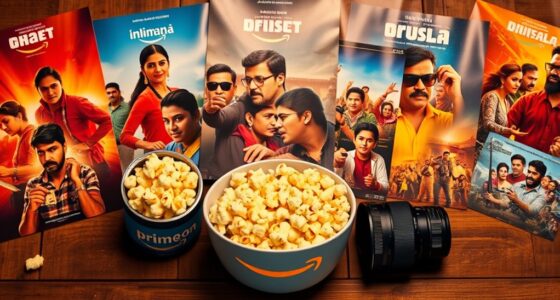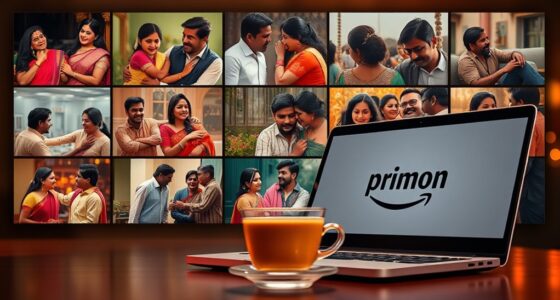Explore the visionaries of Bollywood who shaped Indian cinema with their iconic films. You’ll discover directors like Bimal Roy, who pioneered realism with movies like *Do Bigha Zamin*, and Guru Dutt’s poetic style in classics like *Pyaasa*. Raj Kapoor brought emotion and social themes together, while Yash Chopra defined romance. If you keep exploring, you’ll learn how each filmmaker’s unique vision transformed Bollywood into a global film industry.
Key Takeaways
- The list highlights influential Bollywood directors like Bimal Roy, Guru Dutt, Satyajit Ray, Raj Kapoor, and Yash Chopra.
- It emphasizes their landmark films such as *Do Bigha Zamin*, *Pyaasa*, *Pather Panchali*, *Awaara*, and *Kabhi Kabhie*.
- The background details their unique cinematic styles, themes, and contributions to Indian and global cinema.
- It showcases their innovations in realism, visual storytelling, romance, and cultural depth.
- The overview underscores their lasting impact on Bollywood’s artistic and social storytelling traditions.
Bimal Roy and the Realist Movement in Indian Cinema
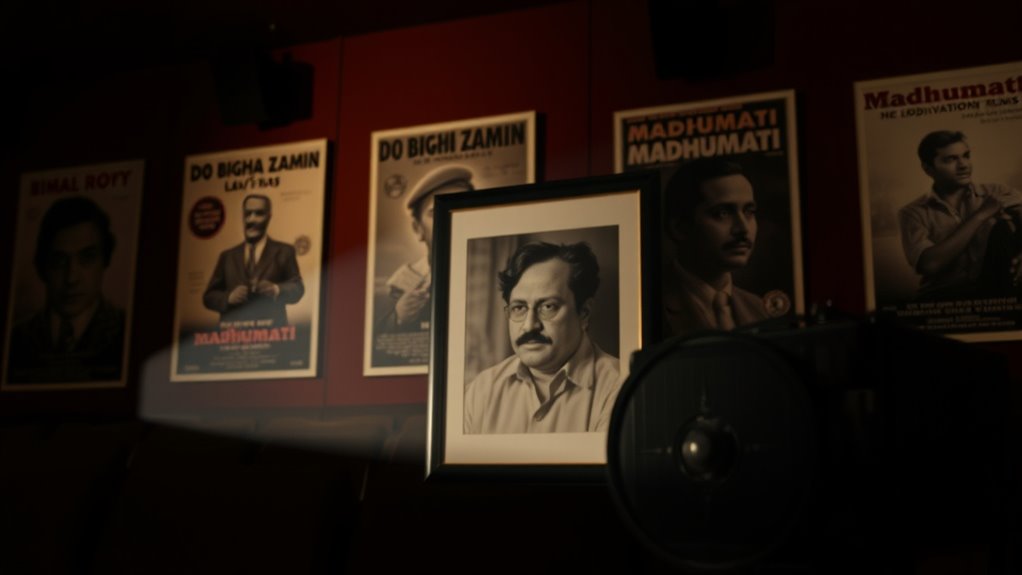
Bimal Roy played a pivotal role in shaping the realist movement in Indian cinema by focusing on socially relevant themes and depicting everyday struggles. You can see his early work in the 1940s, where he made his debut with *Udayer Pathe*, establishing himself as a filmmaker committed to realism. His films often highlighted rural life, poverty, and social injustice, making complex issues accessible to audiences. Roy mastered outdoor camera work, which added authenticity to his stories, and his focus on human dignity resonated across social classes. His films, like *Do Bigha Zamin*, became landmarks, winning international recognition and inspiring future filmmakers. By blending social commentary with compelling storytelling, Roy transformed Indian cinema into a powerful tool for social reflection. Incorporating security vulnerabilities into his narratives, Roy subtly emphasized the importance of safeguarding social and personal integrity in a changing world. His dedication to authentic storytelling helped elevate Indian cinema to a global platform, inspiring a new generation of filmmakers committed to realism. Additionally, his innovative use of visual realism techniques created a more immersive experience for viewers.
Raj Kapoor: The Dreamer and Icon of Bollywood
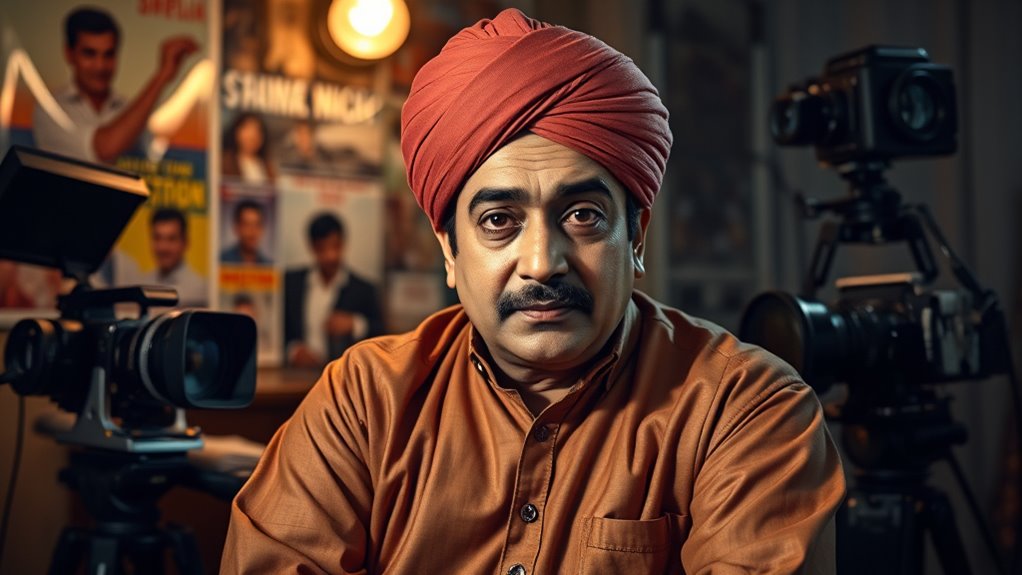
You can see how Raj Kapoor transformed romantic storytelling by blending emotion, music, and social themes into unforgettable films. His memorable characters, often inspired by Charlie Chaplin, set new standards for characterization in Indian cinema. Truly, his innovative approach left a lasting impact that continues to influence filmmakers today. He also pioneered new narrative techniques and visual styles that elevated the art of filmmaking in Bollywood.
Romantic Storytelling Style
Raj Kapoor’s romantic storytelling style captivated audiences by blending heartfelt emotion with vivid visuals and memorable music. You see, he knew how to craft scenes that pulled at your heartstrings, combining love stories with striking imagery and soulful songs. His films often paired Raj Kapoor and Nargis, creating chemistry that felt real and relatable. You could feel the depth of their emotions, whether in tender moments or dramatic confessions. Music played a crucial role, elevating the romance and embedding memorable tunes into your mind. Kapoor’s use of visual storytelling—colorful sets, expressive cinematography—made love stories visually stunning and emotionally resonant. His approach set a benchmark, influencing Bollywood’s romantic narratives for generations to come. Additionally, his innovative use of visual storytelling techniques helped define the romantic genre in Indian cinema, inspiring future filmmakers to explore creative cinematography methods. Moreover, his mastery of space utilization allowed him to craft intimate yet expansive scenes that enhanced the emotional impact. By skillfully manipulating lighting and shadows, Kapoor heightened the mood and emphasized key emotional moments. His ability to create a cohesive aesthetic through consistent visual themes further strengthened the emotional connection with the audience.
Memorable Characterization Techniques
Raj Kapoor’s memorable characterization techniques stemmed from his ability to craft multi-dimensional characters who resonated deeply with audiences. He blended traditional values with modern outlooks, creating complex figures that reflected societal struggles. His films featured the everyman—honest, humble characters who embodied the hopes of the common person. Kapoor also innovated feminine portrayals, presenting women as modern yet rooted in tradition, challenging societal norms. Inspired by international cinema, especially Charlie Chaplin, he introduced the iconic tramp character, symbolizing the underdog’s resilience. His use of symbolism, like the umbrella in *Shree 420*, conveyed deeper themes of love and societal constraints. Kapoor’s characters navigated emotional depths, exploring social issues and human emotions with authenticity, making his storytelling timeless and impactful. Additionally, his integration of innovative automation technology in filmmaking processes helped streamline production and enhanced the visual storytelling experience. His pioneering use of cinematic techniques set new standards for storytelling craftsmanship in Bollywood. Furthermore, Kapoor’s mastery in character development helped forge a lasting connection with audiences across generations.
Impact on Indian Cinema
The innovative characterization techniques developed by Raj Kapoor set a foundation that profoundly influenced Indian cinema’s storytelling approach and global reach. His films, like *Awaara* and *Boot Polish*, gained international acclaim, especially in Asia and Europe, attracting diverse audiences. Kapoor used social commentary to highlight issues like poverty and social justice, blending these themes with love and personal struggle, making his stories deeply rooted in Indian culture. His visual storytelling, music, and dance created a unique cinematic language that shaped future filmmakers. His work earned international awards, including recognition at Cannes and the Karlovy Vary Film Festival, expanding Bollywood’s global presence. Kapoor’s influence endures through his family, legacy, and the countless filmmakers inspired by his visionary approach, which incorporated innovative techniques and cultural storytelling elements. His commitment to authentic cultural representation helped elevate Indian cinema on the world stage, inspiring a new generation of directors to explore innovative filmmaking techniques. Additionally, his pioneering use of artistic influence, such as integrating traditional storytelling with contemporary themes, contributed to his lasting impact on the industry.
Guru Dutt’s Artistic Vision and Classic Films
You can see Guru Dutt’s unique artistic style in his use of lighting and camera angles, which give his films a painting-like quality. His landmark movies, like *Pyaasa* and *Kaagaz Ke Phool*, showcase his mastery of visual storytelling and social themes. Despite personal struggles, his work left a lasting legacy that continues to influence Indian cinema today.
Artistic Style and Influence
Guru Dutt’s artistic style revolutionized Indian cinema by blending visual innovation with deep emotional storytelling. His mastery of light and shadow, especially through chiaroscuro with VK Murthy, created iconic, mood-rich imagery. Dutt’s cinematography, like the mirror shot in *Kaagaz Ke Phool*, pushed technical boundaries. He favored minimalism, emphasizing character inner turmoil over external spectacle, heightening emotional intensity. His films influenced future filmmakers with groundbreaking visuals and realistic storytelling, impacting cinema globally. His work explored universal themes—love, loss, alienation—through poetic symbolism and social commentary. Collaborating with talented artists, Dutt integrated music and dance seamlessly. His films remain timeless, shaping cinematic artistry and inspiring generations.
| Artistic Elements | Influence on Filmmaking | Themes and Narratives |
|---|---|---|
| Light & Shadow | Pathbreaking imagery | Inner turmoil |
| Chiaroscuro | Innovative storytelling | Universal themes |
| Cinematographic innovations | Cinematic legacy | Social commentary |
| Minimalism | Artistic expression | Love, loss, longing |
| Emotional intensity | Cultural impact | Emotional authenticity |
Landmark Films and Legacy
Among Indian cinema’s most influential directors, Guru Dutt left an indelible mark through his visionary approach and timeless films. His classics, like *Pyaasa* (1957), highlight social critique and love, while *Kaagaz Ke Phool* (1959) pioneered Cinemascope in India, exploring a director’s turbulent life. *Sahib Bibi Aur Ghulam* (1962) earned prestigious awards, and *Chaudhvin Ka Chand* (1960) showcased poetic romance with stunning visuals. Despite a short career, his films shaped Bollywood’s narrative style, blending social issues with entertainment. His storytelling, strong performances, and cinematography continue to inspire filmmakers and actors. Guru Dutt’s legacy endures through his artistic vision, influencing generations and remaining a symbol of creative innovation in Indian cinema. Additionally, understanding the resources and tools available in regional areas can help aspiring filmmakers access necessary legal and professional support to pursue their craft, especially considering regional bank hours for financial transactions and planning. Recognizing the cultural context of his work enhances appreciation of his artistic contributions and enduring relevance. Furthermore, his work reflects a deep understanding of social issues, which remains relevant in contemporary storytelling. Notably, his films often incorporated innovative cinematography techniques, setting new standards in Indian filmmaking.
Satyajit Ray’s Global Influence and Landmark Works

Satyajit Ray’s influence on world cinema is undeniable, as his innovative storytelling and artistic vision have left a lasting mark across borders. His debut, *Pather Panchali*, launched his international acclaim, showcasing everyday life with profound depth. Ray’s films explore universal themes like family, social change, and humanism, making them relatable worldwide. His style combines natural lighting and long takes, emphasizing authenticity. Additionally, his use of cinematic techniques has been widely studied and emulated by filmmakers around the globe.
Yash Chopra’s Romantic Masterpieces

Yash Chopra transformed Bollywood with his unforgettable romantic films that blend emotional depth and visual splendor. His storytelling is brought to life through stunning cinematography and iconic soundtracks that elevate each love story. These masterpieces set new standards for romance on screen and continue to inspire filmmakers today. Additionally, his influence can be seen in the distinctive features of his cinematic style that have become a benchmark for romantic storytelling in Indian cinema. His adept use of visual storytelling techniques created immersive worlds that resonated deeply with audiences, often incorporating elements of Italian cuisine such as the warmth and richness that evoke a sense of comfort and nostalgia.
Iconic Romantic Films
Yash Chopra’s romantic films have left an indelible mark on Bollywood by redefining love stories on the big screen. You’ll notice his signature blend of contemporary romance with traditional values, creating timeless classics. Films like *Kabhi Kabhie* explore multi-generational love, while *Silsila* pushes boundaries with its mature portrayal of complex relationships. *Lamhe* stands out for its unconventional romance that defies age and time, and *Dil To Pagal Hai* celebrates modern urban love with unforgettable music. *Veer-Zaara* captures cross-border devotion, resonating deeply with audiences. His use of vibrant colors, exotic locations, and poetic dialogues set new trends. Chopra’s films often feature iconic soundtracks, elevating emotions and leaving a lasting legacy in Bollywood romance. Incorporating creative expression through unique storytelling and visuals has been a hallmark of his work, inspiring countless filmmakers.
Visual Storytelling Brilliance
The visual storytelling in Yash Chopra’s romantic masterpieces elevates his films beyond simple love stories, turning each scene into a work of art that lingers in your mind. His grand, melodramatic visuals blend drama and romance seamlessly, creating immersive experiences. You’ll notice his distinctive use of vibrant color palettes—reds and whites—that set the mood and highlight emotional moments. Signature song picturizations transport you to exotic outdoor locations, enhancing the romantic atmosphere. Chopra’s focus on female characters portrays them as graceful and central to the narrative, adding depth. Choreographed dance sequences serve as storytelling tools, advancing emotional arcs. His innovative cinematography— sweeping landscapes, close-ups, and dynamic camera work—captures intimacy and grandeur, making each frame unforgettable.
Karan Johar’s Modern Blockbusters and Style
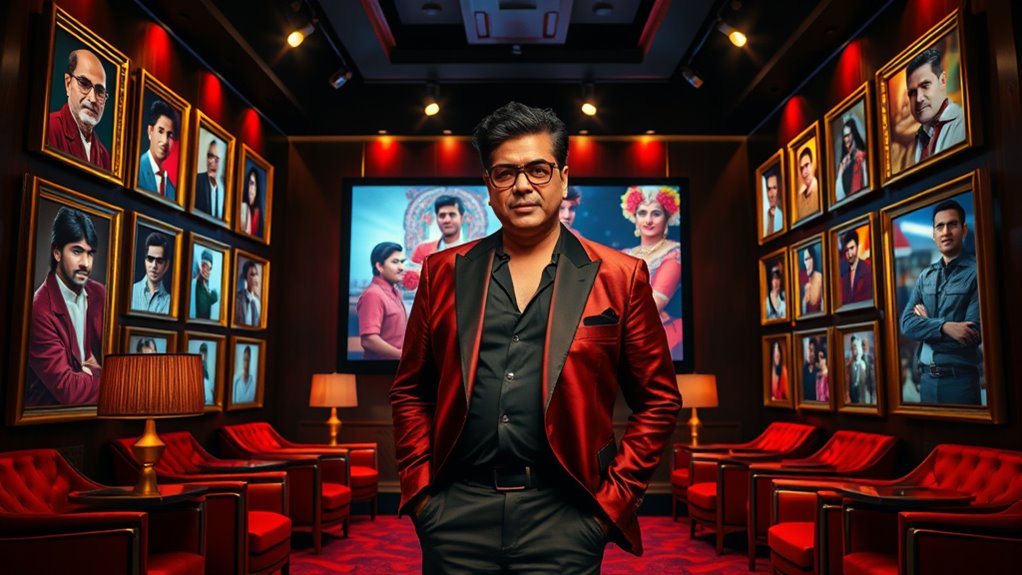
Karan Johar’s modern blockbusters have redefined Bollywood’s approach to storytelling by blending grandeur with emotional depth. You notice his films often showcase larger-than-life love stories set in stunning settings, capturing the essence of Indian culture and family values. His movies, like *Kuch Kuch Hota Hai* and *Kabhi Khushi Kabhie Gham*, resonate with younger audiences by exploring themes of friendship, love, and tradition. Johar’s style emphasizes elaborate song sequences and emotional storytelling, making his films visually spectacular yet heartfelt. He’s also known for launching new talent, such as Alia Bhatt and Varun Dhawan, and for collaborating repeatedly with stars like Shah Rukh Khan. His influence continues to shape contemporary Bollywood, blending modern themes with traditional values seamlessly.
Sanjay Leela Bhansali’s Visual Grandeur

Sanjay Leela Bhansali’s visual grandeur defines a distinctive style that seamlessly blends traditional Indian art with modern cinematic techniques. You’ll notice his lavish set designs, intricate costumes, and vibrant color palettes that create immersive worlds, especially in films like *Devdas* and *Bajirao Mastani*. His use of elaborate choreography and dramatic lighting heightens emotional impact and spectacle. Close-up shots and slow-motion sequences emphasize characters’ internal conflicts and the grandeur of scenes. He skillfully incorporates culturally rich motifs and symbolism from Indian history and mythology, adding depth.
- Lavish set designs and costumes build immersive environments.
- Use of lighting and choreography amplifies emotional storytelling.
- Cultural motifs deepen narrative layers and visual richness.
Rajkumar Hirani’s Heartwarming Narratives
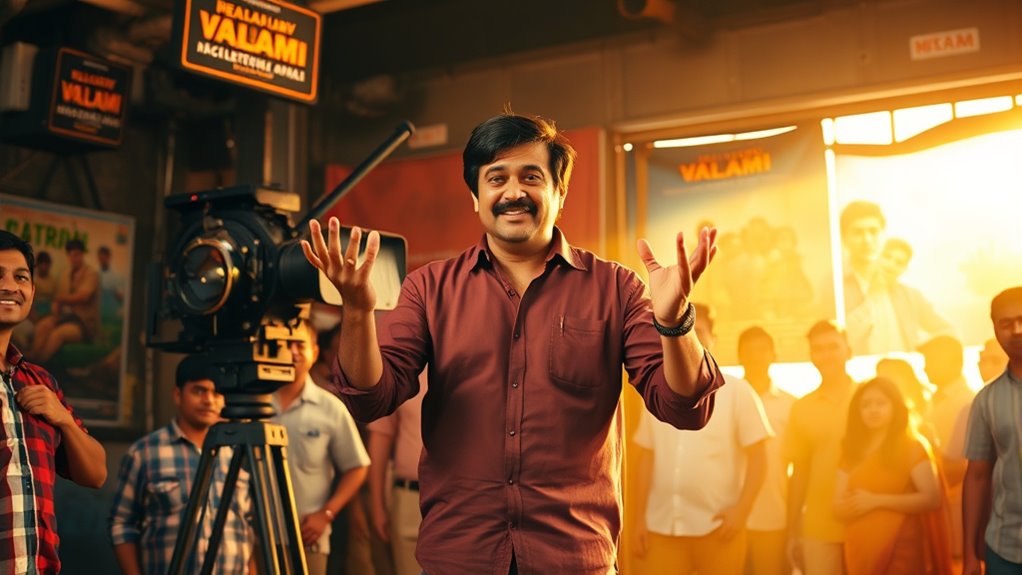
Rajkumar Hirani has crafted a distinctive style of filmmaking that centers on heartwarming stories infused with humor, emotional depth, and social relevance. You’ll notice how he combines entertainment with meaningful messages, making his films resonate deeply. Starting with *Munna Bhai M.B.B.S.*, he created a feel-good comedy that won critical acclaim and established him as a major director. His sequel, *Lage Raho Munna Bhai*, popularized Gandhigiri, blending humor with social values. Films like *3 Idiots* and *PK* broke box office records while addressing important issues like education and belief systems. You can see his signature approach in every project—stories that touch the heart, provoke thought, and entertain. Hirani’s films continue to inspire audiences worldwide, cementing his legacy as a master of heartwarming, socially conscious storytelling.
Hrishikesh Mukherjee’s Comedy and Socially Conscious Films
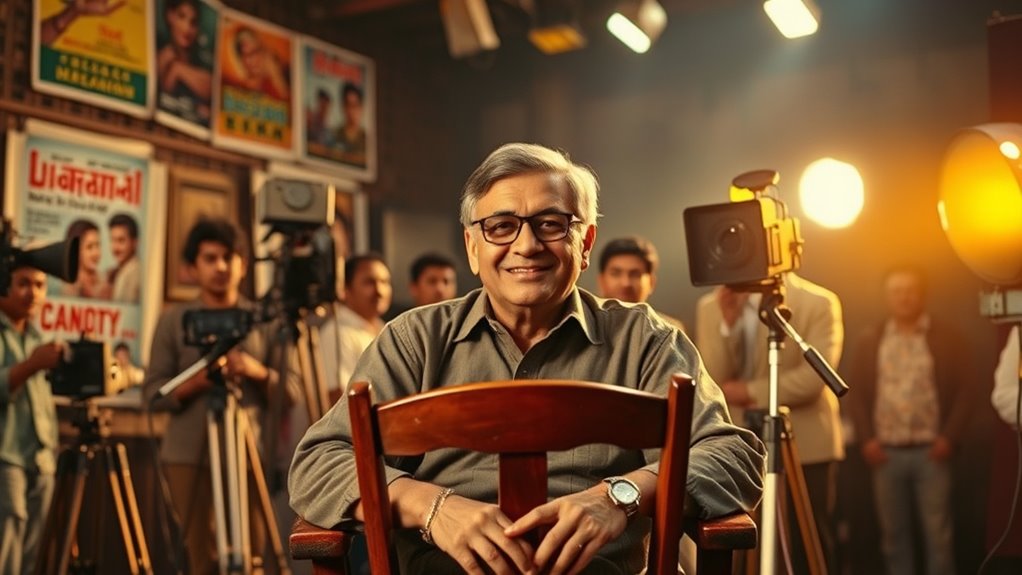
Hrishikesh Mukherjee revolutionized Indian cinema with a unique blend of comedy and social consciousness that connected deeply with audiences. His films balanced humor with meaningful themes, making social issues relatable. You’ll notice his early work, like *Musafir*, wasn’t a hit, but *Anari* showcased his talent for storytelling. He pioneered ‘middle cinema’, blending mainstream appeal with thoughtful content. His socially conscious films, such as *Anuradha* and *Namak Haraam*, addressed alienation, social inequality, and moral values. His comedies, including *Guddi*, *Bawarchi*, and *Gol Maal*, highlighted family dynamics and everyday life, often infused with satire. These films reflected middle-class values, emphasizing relationships, social pressures, and humor, leaving a lasting cultural impact on Indian cinema.
Anurag Kashyap’s Edgy and Revolutionary Storytelling

Anurag Kashyap has revolutionized Indian cinema by embracing edgy, unconventional storytelling that challenges traditional norms. From his early days with “Paanch,” which remained unreleased, to films like “Black Friday” and “Satya,” he’s pushed boundaries with raw, realistic narratives. His notable works—”No Smoking,” “Dev D,” and “Gulaal”—are known for their bold themes and innovative techniques, including guerrilla filmmaking and inventive lighting. Kashyap’s films often explore socially relevant issues, creating immersive experiences that defy mainstream conventions. His influence extends beyond India, inspiring filmmakers worldwide. With awards, international screenings, and a reputation for fearless storytelling, Kashyap has established himself as a visionary who continually challenges the status quo, shaping the future of Indian cinema with his revolutionary approach.
Frequently Asked Questions
How Did Bimal Roy Influence Indian Social Realism in Cinema?
You see, Bimal Roy profoundly influenced Indian social realism by adopting Italian Neo-Realism techniques, emphasizing authentic location shots, and naturalistic performances. He focused on pressing social issues like poverty, caste discrimination, and urban migration, using subtle storytelling rather than melodrama. His films, like “Do Bigha Zamin,” set new standards for socially conscious cinema, inspiring future filmmakers and establishing a legacy of realism that continues to shape Indian cinema today.
What Makes Raj Kapoor a Legendary Figure in Bollywood History?
Have you ever wondered what makes Raj Kapoor a legend? You see, his innovative storytelling, charismatic screen presence, and ability to blend social themes with entertainment set him apart. His iconic films like “Awaara” and “Barsaat” not only achieved critical acclaim but also influenced generations. With numerous awards and global recognition, he became a cultural icon, earning the title of the “Clark Gable of Indian cinema” and leaving an indelible mark.
In What Ways Did Guru Dutt Revolutionize Indian Film Artistry?
You see, Guru Dutt revolutionized Indian film artistry by blending poetic storytelling with innovative cinematography and deep social commentary. He experimented with dark themes, capturing complex emotions and inner struggles that went beyond typical Bollywood fare. His use of symbolism, visual storytelling, and collaboration with talented artists created films that are both artistically rich and emotionally impactful, inspiring future filmmakers and shaping the distinct aesthetic of Indian cinema.
How Did Satyajit Ray Impact Global Perceptions of Indian Cinema?
Imagine a bridge connecting worlds—that’s how Satyajit Ray transformed global views of Indian cinema. His films, rooted in realism and human emotion, showcased India’s rich stories and social realities, breaking stereotypes. By earning international acclaim, debuting at Cannes, and receiving an Honorary Oscar, Ray made Indian cinema a respected art form worldwide. His innovative storytelling and universal themes opened doors, inspiring filmmakers and audiences across the globe to see India’s cinematic voice.
What Distinguishes Yash Chopra’S Romantic Filmmaking Style?
You notice Yash Chopra’s romantic filmmaking style stands out because of its emotional depth, stunning visuals, and memorable music. He crafts stories with strong female leads and uses exotic locations like snowy mountains to evoke serenity and passion. His elegant visuals, such as chiffon saris and dreamlike sequences, create a timeless romance that resonates deeply with audiences, making his films iconic and influential across generations.
Conclusion
As you walk through this gallery of cinematic visionaries, remember each director as a guiding star illuminating Bollywood’s vast sky. Their landmark films are constellations, shaping your understanding of Indian cinema’s soul. Just as a lighthouse guides ships home, their artistry beckons you deeper into stories that reflect dreams, realities, and passions—shaping the enduring voyage of Bollywood’s creative horizon.


